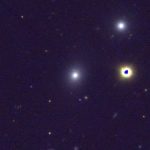Key Takeaways:
- A rogue white dwarf star, WD 0810–353, previously believed to pose a threat to our solar system in approximately 29,000 years, is now deemed unlikely to encounter our system, ensuring its safety.
- The white dwarf was initially identified by the Gaia space telescope, but recent research indicates that the measured approach speed by Gaia was incorrect, and the predicted close encounter is not expected to happen.
- Astronomers Vadim Bobylev and Anisa Bajkova utilized the Gaia dataset to identify stars heading toward our solar system, pinpointing WD 0810–353 as a potential hazard due to its trajectory.
- WD 0810–353, a white dwarf star, resembles what our sun might become in about a billion years when it transforms into a white dwarf after its red giant phase.
- The unusually large magnetic field of WD 0810–353, initially overlooked by Gaia, played a crucial role in the misinterpretation of its trajectory, highlighting the importance of considering magnetic fields in astronomical observations.
Recent findings have quelled concerns about a potential celestial threat to our solar system from a rogue white dwarf star known as WD 0810–353. Initial predictions based on Gaia space telescope observations suggested that this wandering dead star could collide with our solar system in approximately 29,000 years. However, new research has debunked this alarming forecast, providing reassurance about the safety of our solar system in the distant future.
In the vast expanse of cosmic time, 29,000 years may seem relatively short. Nonetheless, the proximity of the predicted encounter raised concerns, considering the potential disturbances it could cause to the Oort cloud—an accumulation of comets and icy bodies at the solar system’s edge. The original assessment involved the Gaia telescope, which meticulously maps the positions of over a billion stars in the Milky Way.
Astronomers Vadim Bobylev and Anisa Bajkova, in 2022, identified WD 0810–353 as a candidate for a close encounter with our solar system. The white dwarf, a remnant left when stars similar to our sun perish, could offer a glimpse into the sun’s future as it transitions into a white dwarf, around a billion years after its red giant phase.
The close proximity of WD 0810–353, approximately half a light-year from our solar system, raised concerns about potential disruptions to the Oort cloud. The gravitational influence of the rogue white dwarf could potentially alter the trajectory of icy bodies within the Oort cloud, leading them towards the inner solar system and Earth.
However, recent developments suggest that the original observations were flawed. The Gaia telescope, while precise in its measurements, miscalculated the approach speed of WD 0810–353. Astronomer Stefano Bagnulo clarified that the close encounter between the rogue white dwarf and the sun, as initially predicted, is not expected to occur. Furthermore, WD 0810–353 may not be moving towards our solar system at all, eliminating the perceived cosmic hazard.
The discrepancy in observations arose from the oversight of an unusual feature of WD 0810–353—its remarkably large magnetic field. In astronomical observations, magnetic fields play a pivotal role in understanding various physical aspects of a star. The Gaia telescope’s oversight of this crucial factor led to the misinterpretation of the white dwarf’s trajectory.
To rectify this, astronomers turned to the Very Large Telescope (VLT) and employed the FOcal Reducer and low dispersion Spectrograph 2 (FORS2). This instrument enabled a detailed analysis of the spectra of WD 0810–353, considering its intense magnetic field. The resulting findings indicate that the trajectory and velocity of the white dwarf are likely influenced by its strong magnetic field, ensuring that the solar system is not at risk from this particular celestial wanderer.
In conclusion, the potential threat posed by WD 0810–353 to our solar system has been debunked, highlighting the importance of considering magnetic fields in astronomical observations. The revised understanding provides a sense of relief regarding the future safety of our solar system from this particular rogue white dwarf.


